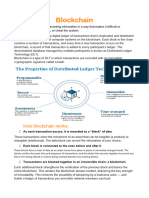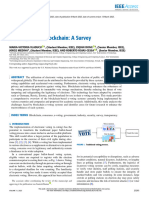0% found this document useful (0 votes)
26 views9 pagesChapter 1
The document provides an overview of blockchain technology, detailing its mechanisms, types, origins, objectives, and challenges. It categorizes blockchains into public, private, consortium, and hybrid types, each with distinct features and use cases. Additionally, it discusses the evolution of blockchain, key milestones, and the technical components involved in blockchain transactions.
Uploaded by
jtjasrotia123Copyright
© © All Rights Reserved
We take content rights seriously. If you suspect this is your content, claim it here.
Available Formats
Download as PDF, TXT or read online on Scribd
0% found this document useful (0 votes)
26 views9 pagesChapter 1
The document provides an overview of blockchain technology, detailing its mechanisms, types, origins, objectives, and challenges. It categorizes blockchains into public, private, consortium, and hybrid types, each with distinct features and use cases. Additionally, it discusses the evolution of blockchain, key milestones, and the technical components involved in blockchain transactions.
Uploaded by
jtjasrotia123Copyright
© © All Rights Reserved
We take content rights seriously. If you suspect this is your content, claim it here.
Available Formats
Download as PDF, TXT or read online on Scribd
/ 9























































































